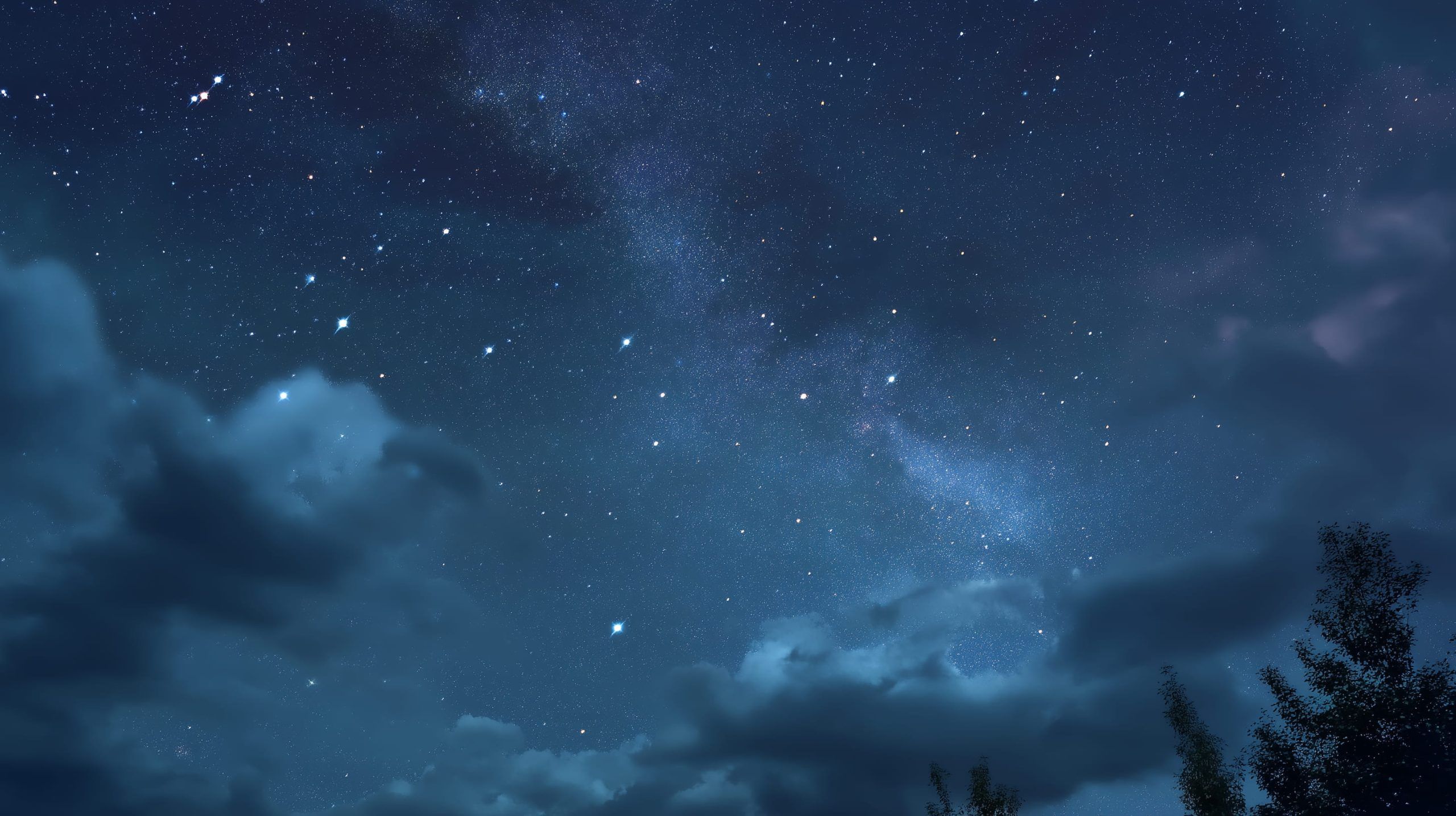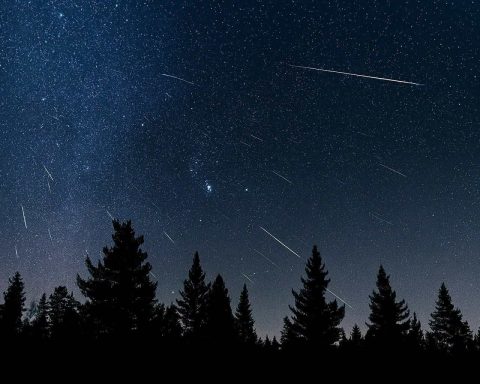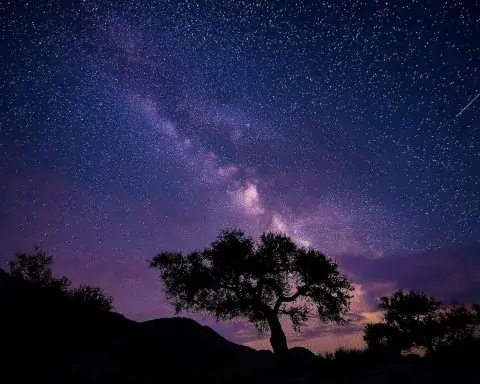- The Perseid meteor shower peaks on the night of August 12 into the early hours of August 13, 2025, with an expected rate of 10–20 meteors per hour under an 84% full moon.
- Even with the bright Moon, the brightest Perseid fireballs and colorful streaks are expected to punch through the moonlight.
- The best viewing window is after midnight, with the peak around 2–3 AM local time as the Perseus radiant climbs higher.
- Venus and Jupiter will appear about 1° apart in the pre-dawn sky on August 12, 2025, with their closest approach on August 11–12.
- A planetary parade will feature six planets above the horizon at some point on August 12–13, 2025: Venus, Jupiter, Saturn, Mars, Uranus, and Neptune.
- Mercury will not be visible during August 12–13, 2025, as it remains too close to the Sun.
- There are no eclipses on August 12–13, 2025, but a Blood Moon total lunar eclipse is expected on September 7, 2025, visible across Europe, Africa, and Asia.
- Space weather suggests no major geomagnetic storm for August 12–13, 2025, with NOAA forecasting quiet-to-unsettled conditions, though a CME on August 8–9 did produce auroras at high latitudes.
- The International Space Station (ISS) may have visible passes on August 12–13, 2025, and SpaceX Starlink satellite trains could appear shortly after launches around those dates.
- Observing tips include using a reclining chair, bringing a blanket, choosing a dark location away from light pollution, and allowing about 30 minutes for your eyes to adapt to the dark.
Perseid Meteor Shower Peaks Under Bright Moonlight
One of the year’s most beloved meteor displays – the Perseid meteor shower – reaches its peak on the night of August 12 into the early hours of August 13. Normally, under dark skies, you might see 40–50 “shooting stars” per hour during the Perseids’ peak [1]. This year, however, a glaring 84%-full moon will outshine many of the fainter meteors, cutting visible rates down to an expected ~10–20 per hour at best [2] [3]. Don’t be discouraged – the Perseids are famed for bright fireballs and long, colorful streaks, so the brightest meteors will still punch through the moonlight [4]. In fact, NASA experts insist the shower is “still worth catching” despite the moon’s interference [5] [6]. The shower’s activity has been building since mid-July (as Earth plows through debris of Comet Swift-Tuttle) and will remain active for several days after the peak [7], but the highest meteor counts are forecast for late Aug 12 into pre-dawn Aug 13 [8].
When and how to watch: To maximize your Perseid viewing, plan to head out after midnight, once the Perseus constellation radiant is higher. The best hours are between about 12 AM and dawn (peaking ~2–3 AM local time), when the meteor rates climb [9] [10]. Get as far from city lights as possible – a safe, dark rural location with a wide-open view of the sky is ideal [11]. Once outside, avoid looking directly at the Moon (its glare will ruin your night vision) [12]. Allow about 30 minutes for your eyes to adapt to the dark, and resist the urge to check your phone or any bright light source during that time [13]. The Perseids can appear in any part of the sky (not just near Perseus), so a reclining posture that lets you scan wide swaths of sky is best. NASA’s Bill Cooke quips: “You’re not going to see Perseids around suppertime… You’re going to have to go out later” [14] – so take a nap if needed, and be ready to stay up late!
Viewing tips from the experts:
- Get comfortable: Don’t stand and crane your neck for hours. “You’ll get really tired and bored quick. Get a nice lounge chair where you’re comfortable,” advises Robert Lunsford of the American Meteor Society [15]. Bring a blanket or sleeping bag to stay warm – even in August, late-night temperatures can chill you. “It’s going to get chilly, even in August,” notes Michelle Nichols of Chicago’s Adler Planetarium [16].
- Aim for darkness: Find a spot with minimal light pollution (far from streetlights and urban glow). The more stars you can see with the naked eye, the more meteors you’re likely to catch [17]. If possible, travel to the countryside or a designated dark-sky park.
- Use the Moon to your advantage: Position yourself so that an object (like a building or hill) blocks the Moon, or simply lie on the ground and look away from the Moon towards the darkest part of your sky [18]. This will help preserve your night vision and allow fainter meteors to become visible.
- Be patient: Meteor watching is a waiting game. Give yourself at least an hour of observing time – meteors often come in spurts with lulls in between. Relax, enjoy the summer night ambiance, and you might also catch a bonus fireball meteor (the Perseids are known for occasional extra-bright meteors that can elicit gasps).
(Fun fact: The Perseids are bits of debris from comet Swift-Tuttle. Every year in mid-August, Earth passes through this comet’s dust trail. As those tiny comet fragments hit our atmosphere at 37 miles per second, they burn up in flashes of light [19] [20]. That’s why we see the meteors seemingly “rain” from the direction of the constellation Perseus!)
Venus and Jupiter’s Dazzling Dawn Conjunction 🌟
Early risers on Aug 12–13 are in for a treat: the two brightest planets in our sky, Venus and Jupiter, are having an exceedingly close meet-up low in the east before sunrise. In the pre-dawn hours of August 12, Venus and Jupiter will appear just ~1° apart – so close that they look like a brilliant “double star” [21]. (For reference, 1° is about the width of your pinky finger held at arm’s length [22].) This Venus–Jupiter conjunction is so tight that you’ll be able to cover both planets at once with that outstretched pinky [23]! They’ll be the two beacon-like points of light in the eastern sky – Venus is the blazingly bright “Morning Star” and Jupiter will shine nearby, somewhat less bright but still very prominent [24] [25]. The pair approaches closest on Aug 11–12, effectively “kissing” at dawn, and will still be very near each other on Aug 13 (by then Jupiter will have just edged east of Venus as they swap places) [26]. This stunning conjunction is one of the highlight celestial events of the year, according to NASA [27] [28] – it’s not often we see the two brightest planets virtually side by side.
How to see the planetary duo: Look east in the hour before sunrise (around 4:30–5:30 AM local time, varying by location). Venus and Jupiter will be low above the horizon, so you’ll need an unobstructed view (find a spot with a clear eastern horizon, free of trees or buildings) [29] [30]. Being farther south helps, since these planets climb a bit higher in more southerly latitudes before daybreak [31] [32]. If you’re in northern Europe or Canada, start looking as early as possible – the sky starts brightening quickly and the planets could get lost in dawn’s glow [33]. Venus will gleam pure white, while Jupiter appears as a steady cream-colored point nearby. No telescope is needed to enjoy this show – they are bright enough to see even in suburban skies. (But if you do have binoculars, a quick peek might reveal some of Jupiter’s Galilean moons or Venus’s crescent phase!) Just remember to put optics away before the Sun comes up to avoid accidental eye damage once daylight arrives [34] [35].
This Venus–Jupiter conjunction coincides exactly with the Perseid meteor peak, effectively creating a double feature in the sky [36]. Imagine: while meteors streak overhead in the predawn darkness, Venus and Jupiter gleam together on the eastern horizon – a beautiful backdrop for anyone photographing the night sky. Observers have likened close Venus-Jupiter pairings to “two lanterns in the twilight,” so don’t miss this chance to see the cosmic duo almost touching.
Planets on Parade: Saturn, Mars and More
Venus and Jupiter aren’t the only planets making an appearance. In fact, six of the solar system’s planets are above the horizon at some point on Aug 12–13 (all except Pluto and Earth itself, of course!). Stargazers have dubbed this a “planet parade” – though not all six are easy to spot at once. Here’s what to look for:
- Saturn – The ringed planet is now approaching its annual peak brightness (opposition is later this month), so it’s a great time to observe Saturn. It rises in the east by around 10 p.m. in early August [37], and by midnight it’s climbing high. By dawn, Saturn will be high in the southern sky shining a steady golden light [38]. Even a small telescope or good binoculars might reveal Saturn’s rings or a hint of its brightest moon, Titan. Interestingly, Saturn is currently hanging out very close to distant Neptune in the constellation Pisces – astronomers note the two planets were only ~1.1° apart in early August [39]. Neptune itself is far too faint to see without a telescope, but it’s neat to know that in the eyepiece, Saturn and Neptune can be seen nearly side-by-side this month [40].
- Mars – The Red Planet is a bit player this time of year. Mars is visible just after sunset, very low in the western sky [41]. It’s now modest in brightness (about magnitude 1.6 [42], similar to a Big Dipper star) since it’s several months past its last opposition. If you have a clear view toward the west-northwest, you might catch a ruddy “star” twinkling for a short while after dusk. Mars will set roughly an hour or two after the Sun, so timing is tight [43]. (By late August, Mars will disappear behind the Sun’s glare entirely.) Don’t expect to see surface details – Mars is small and distant now, and telescopes won’t show much more than a tiny rust-colored dot [44].
- Mercury – Mercury is the tricky one. Unfortunately for those on Aug 12–13, Mercury is not yet visible – it’s still too close to the Sun’s glare. The innermost planet will begin to peek above the eastern horizon around mid-to-late August for early birds, but during our target nights Mercury is essentially out of view [45]. (Mark your calendar for ~August 18–19 when Mercury joins the dawn lineup, if you’re keen – by then we’ll truly have five planets + the Moon in the morning sky [46] [47].)
- Uranus & Neptune – These two ice giants require optical aid, but we mention them for completeness. Uranus can be spotted with binoculars or a small scope in the east-southeast before dawn, lurking not far from the Pleiades star cluster [48] [49]. It shines around magnitude 5.8 – technically visible to the naked eye under very dark skies if you know exactly where to look. Neptune, as noted, is near Saturn in Pisces and glows at magnitude 7.8, necessitating a telescope. While not visible to the unaided eye, it’s fascinating that all these worlds are sharing the sky. Around August 18, the Moon, Mercury, Venus, Jupiter, Uranus, Saturn and Neptune will all be up before sunrise – a true multi-planet spectacle [50] [51]. During our Aug 12–13 window, we’re just shy of that, but you can still impress friends by saying “at this moment, six planets are above the horizon!”
No eclipses this time: One notable thing not happening on Aug 12–13 is an eclipse – neither solar nor lunar. The Moon will be in a bright gibbous phase rather than crossing Earth’s shadow or the Sun. However, skywatchers can look forward to a dramatic “Blood Moon” total lunar eclipse coming soon on Sept. 7, 2025 [52] (visible across Europe, Africa, and Asia). So while August 12–13 has no eclipse, it certainly offers plenty of other cosmic eye candy.
Aurora Watch: Any Northern Lights in the Forecast?
Many skywatchers are also curious about the aurora borealis – the enchanting “Northern Lights.” August 2025 finds us near the peak of the 11-year solar activity cycle, meaning the Sun is freckled with sunspots and solar flares that can trigger auroras more often. In fact, just a few days before our target dates, an incoming coronal mass ejection (CME) sparked geomagnetic storm alerts. On August 8–9, space weather forecasters predicted a G1–G2 level geomagnetic storm, and auroras were expected from Alaska down to U.S. states like Illinois under the right conditions [53] [54]. That moderate storm (Kp 6) did materialize, treating lucky observers at high latitudes to auroral glows.
For August 12–13 itself, no major geomagnetic storm is currently forecast (the recent disturbance has passed). According to NOAA’s Space Weather Prediction Center, geomagnetic activity is expected to be quiet-to-unsettled in the immediate term (barring any surprise flares) [55]. That means a strong aurora display is unlikely on these nights – at least for middle latitudes. However, if you live in high northern latitudes (Canada, Scandinavia, etc.) it’s always worth keeping an eye on the northern horizon on any clear, dark night. Even a minor geomagnetic uptick can produce a subtle auroral glow or faint green curtain low on the horizon for those far north. Aurora forecasting resources like NOAA’s SWPC Aurora Dashboard and the ovation model can give short-term predictions a day or hours in advance [56]. If a sudden solar eruption occurs on Aug 10–11, it could send a CME our way by the 12th or 13th – so aurora chasers, stay alert to space weather news.
In summary, don’t bank on a big Northern Lights show during the Perseid peak this year – but the very active Sun means one could always be surprised. If you happen to be out meteor-hunting under a northern sky, occasionally glance northward; you might catch a delicate greenish glow or pulsing arc, especially in the pre-dawn hours when auroras often intensify. And if not, you’ll still have meteors zipping overhead and planets shining – not a bad consolation prize!
Man-Made “Stars”: Spotting Satellites and the ISS
While you’re out enjoying natural celestial phenomena, keep an eye out for human-made objects gliding across the sky. Hundreds of satellites are visible to the naked eye – on any clear night, it’s likely you’ll see a few if you watch patiently [57] [58]. These appear as steady moving “stars” (usually not blinking, unlike airplanes) that travel in a straight line across the starfield over a few minutes. The brightest of all is the International Space Station (ISS), which can outshine most stars. When visible, the ISS looks like a fast-moving, non-twinkling bright point of light, typically appearing a couple of hours after sunset or before sunrise when it catches sunlight against the dark sky. Its exact pass times depend on your location – you can check NASA’s “Spot the Station” service to find if the ISS will fly over your area during Aug 12–13. If it does, it’s definitely worth a look: many first-timers are amazed to realize that “star” is actually a football-field-sized outpost with astronauts aboard, orbiting ~250 miles up!
Satellite “flares” and trains: You might also catch brief flares or glints from satellites. Some satellites briefly reflect the sun and flash brightly for a second or two – a treat if you catch one. Additionally, SpaceX’s Starlink satellites have become a common sight. Right around Aug 12–13, SpaceX is launching a new batch of Starlinks into orbit [59], which means people in some areas might witness the eerie spectacle of a “Starlink train” in the days after launch. This looks like a chain of bright pearls crossing the sky – a line of several bright satellite dots moving in procession. It’s a dazzling but short-lived formation, usually seen shortly after launch when the satellites are still clustered together in low orbits [60] [61]. As they climb and spread out, the “train” disperses and individual Starlinks become dimmer [62]. If you do spot a string of lights on, say, the evening of Aug 13 or 14, don’t worry – it’s not an alien invasion, just Elon Musk’s satellites catching the sun! (These are often mistaken for UFOs by surprised observers [63].) To know when and where to look, you can use online tools like FindStarlink or various stargazing apps which update Starlink visibility predictions [64].
Between the ISS, Starlinks, and other satellites, skywatchers on Aug 12–13 are likely to see a few artificial movers in addition to natural meteors. One pro tip: if you’re trying to distinguish a satellite vs. a meteor, remember meteors are blink-and-you-miss-it fast, lasting only a second or less as a streak of light. Satellites, on the other hand, glide steadily for minutes. As one astronomer wryly put it, “a satellite looks like a star that has taken leave of its senses” – calmly drifting rather than staying put [65]. Spotting these satellites can be a fun side-quest during your night under the stars.
Make the Most of the Cosmic Showcase
With so many celestial events converging on August 12–13, 2025, it’s a perfect opportunity to immerse yourself in skywatching. To recap, here’s what’s happening and how to enjoy it best:
- Perseid Meteors – Peak on Aug 12–13 (night to pre-dawn). Expectation: ~10–20 meteors/hour under an 84% gibbous moon [66]. Best view: after midnight to dawn, find a dark location, look away from the Moon. You’ll see fast, white or yellow meteors radiating from the north-east (Perseus) part of the sky. Tip: Be patient and get comfy – bring a reclining chair or blanket and let your eyes adapt [67].
- Venus–Jupiter Conjunction – Visible at dawn on Aug 12 and 13 low in the east. What to see: two super-bright “stars” extremely close together – almost touching. Venus is the brighter one, Jupiter just next to it [68]. Best view: 60–30 minutes before your local sunrise, unobstructed eastern horizon. Tip: Try covering them with your pinky at arm’s length – amazingly, they’ll hide behind one finger at closest approach! [69]
- Other Planets – Saturn rises by late evening and shines high in the south by early morning [70] (look for a golden steady light). It’s a great time to point a telescope at Saturn’s rings. Mars is very low after sunset in the west (a faint orange dot, sets early) [71]. Uranus (pre-dawn east) and Neptune (near Saturn) are around if you have optics or a star chart. No Mercury yet (wait until later in August). The Moon will rise late evening as a waning gibbous – bright and beautiful in its own right. Though it hinders meteor spotting, you can use binoculars to admire lunar craters and seas in the moonlight.
- Possible Aurora – Not forecasted as of now for Aug 12–13, but if you’re in high latitudes, remain alert. A surprise solar storm could always spark a green auroral arc on the horizon. (Just a few days ago a CME-triggered geomagnetic storm brought auroras as far south as ~40°N latitude [72].) Check NOAA aurora alerts if you’re hoping to catch the Northern Lights.
- Satellites & ISS – While gazing up, you’ll likely notice some satellites. The ISS may make visible passes (check local timings – it generally appears as a bright moving star in early morning or evening). Around these dates, Starlink satellite trains are also a possibility shortly after SpaceX’s planned launches [73]. These look like a straight row of lights gliding across the sky – a quirky sight to share with friends. Tip: If you see a moving light that doesn’t blink, it’s probably a satellite. If it shoots and is gone in a flash, it was a meteor.
Finally, don’t forget to simply enjoy the night sky itself. If you can escape city lights, the summer Milky Way will spill across the heavens – a gorgeous band of starry glow arching high overhead through Cygnus, Aquila, and Sagittarius. Take moments between meteor scans to appreciate the sparkling constellations: the Summer Triangle shines nearly above, Cassiopeia and Perseus in the northeast, and Scorpius setting in the southwest. August nights are warm and inviting, making it a perfect time to introduce family or friends to stargazing. Pack some snacks, bring a star chart or astronomy app, and turn the night into a cosmic adventure.
In summary, the nights of August 12–13, 2025 offer a feast of celestial delights – from streaking meteors and a rare planet-to-planet rendezvous, to bright planets, potential auroras, and even human-made satellites silently traversing the stars. It’s not often so many sky events align at once. So if skies are clear, make plans to look up! As NASA encourages, “with some good planning and timing, you could be in for a real treat” [74]. Bring your curiosity (and maybe a wish or two for those shooting stars). This cosmic show is free for all – and it’s one you won’t want to miss. Clear skies!
Sources: NASA [75] [76] [77] [78]; Smithsonian Magazine [79] [80]; EarthSky [81] [82]; BBC Sky at Night [83]; Space.com [84] [85]; Astronomy Magazine [86]; American Meteor Society; NOAA Space Weather Prediction Center [87].
References
1. www.nasa.gov, 2. www.nasa.gov, 3. science.nasa.gov, 4. www.nasa.gov, 5. www.smithsonianmag.com, 6. www.smithsonianmag.com, 7. www.smithsonianmag.com, 8. www.smithsonianmag.com, 9. www.nasa.gov, 10. www.smithsonianmag.com, 11. www.nasa.gov, 12. www.nasa.gov, 13. www.smithsonianmag.com, 14. www.nasa.gov, 15. www.smithsonianmag.com, 16. www.smithsonianmag.com, 17. www.nasa.gov, 18. www.nasa.gov, 19. www.smithsonianmag.com, 20. www.smithsonianmag.com, 21. www.skyatnightmagazine.com, 22. earthsky.org, 23. earthsky.org, 24. science.nasa.gov, 25. science.nasa.gov, 26. www.skyatnightmagazine.com, 27. science.nasa.gov, 28. science.nasa.gov, 29. www.skyatnightmagazine.com, 30. www.skyatnightmagazine.com, 31. www.skyatnightmagazine.com, 32. www.skyatnightmagazine.com, 33. www.skyatnightmagazine.com, 34. www.skyatnightmagazine.com, 35. www.skyatnightmagazine.com, 36. www.astronomy.com, 37. science.nasa.gov, 38. science.nasa.gov, 39. www.astronomy.com, 40. www.astronomy.com, 41. science.nasa.gov, 42. www.astronomy.com, 43. science.nasa.gov, 44. www.astronomy.com, 45. science.nasa.gov, 46. www.skyatnightmagazine.com, 47. www.skyatnightmagazine.com, 48. www.skyatnightmagazine.com, 49. www.skyatnightmagazine.com, 50. www.skyatnightmagazine.com, 51. www.skyatnightmagazine.com, 52. www.space.com, 53. www.space.com, 54. www.space.com, 55. www.swpc.noaa.gov, 56. www.space.com, 57. www.space.com, 58. www.space.com, 59. www.space.com, 60. www.space.com, 61. www.space.com, 62. www.space.com, 63. www.space.com, 64. www.space.com, 65. www.space.com, 66. science.nasa.gov, 67. www.smithsonianmag.com, 68. earthsky.org, 69. earthsky.org, 70. science.nasa.gov, 71. science.nasa.gov, 72. www.space.com, 73. www.space.com, 74. www.skyatnightmagazine.com, 75. www.nasa.gov, 76. www.nasa.gov, 77. www.nasa.gov, 78. science.nasa.gov, 79. www.smithsonianmag.com, 80. www.smithsonianmag.com, 81. earthsky.org, 82. earthsky.org, 83. www.skyatnightmagazine.com, 84. www.space.com, 85. www.space.com, 86. www.astronomy.com, 87. www.swpc.noaa.gov










